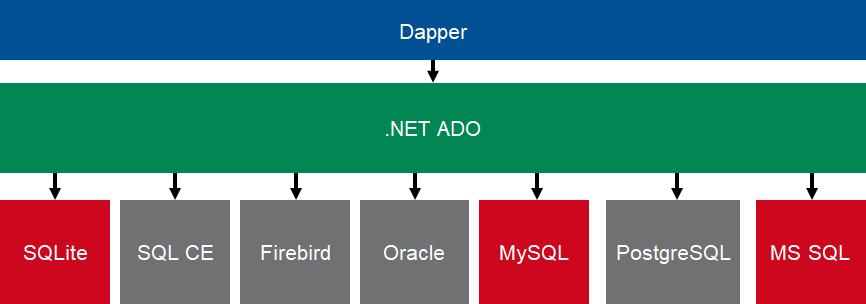Playground for testing the StackExchange object mapping Library Dapper.
See this page for more first hand examples: Dapper Tutorial
dotnet test ./src
By default all examples are run against the respective dockerized database systems.
Dapper supports a variety of database management systems (DBMS). In this sample project the following DBMS were used:
- Microsoft SQL Server (MS SQL)
- SQLite
- MySQL
This project consists mainly of code samples showing how queries and commands can be executed by using Dapper.
/// Object with the data, that will be inquired.
public class OrderItem
{
public int Id { get; }
public string CustomerName { get; }
public DateTime OrderDate { get; }
public string Address { get; }
}
public class DapperQuery
{
private const string Sql = @"
SELECT TOP (20)
o.OrderID AS [Id],
c.ContactName AS [CustomerName],
o.OrderDate AS [OrderDate],
o.ShipAddress AS [Address],
FROM
[dbo].[Orders] AS o
INNER JOIN [dbo].[Customers] AS C
ON c.[CustomerID] = o.[CustomerID]
ORDER BY
c.ContactName";
private readonly System.Data.IDbConnection connection;
public DapperQuery(IDbConnection openConnection)
{
this.connection = openConnection;
}
public IReadOnlyCollection<OrderItem> GetOrders()
{
return this.connection.Query<OrderItem>(Sql).ToList();
}
}There are also some examples using NHibernate to display the differences between these two frameworks.
// Sample NHibernate implementation of the same query
public class NHibernateQuery
{
private readonly NHibernate.ISession session;
public NHibernateQuery(ISession session)
{
this.session = session;
}
public IReadOnlyCollection<OrderItem> GetOrders(string customerNameContains)
{
OrderItem orderItem = null;
CustomerEntity customerAlias = null;
return this.session
.QueryOver<OrderEntity>()
.JoinAlias(x => x.Customer, () => customerAlias)
.SelectList(l => l
.Select(x => x.Id).WithAlias(() => orderItem.Id)
.Select(() => customerAlias.ContactName)
.WithAlias(() => orderItem.CustomerName)
.Select(x => x.OrderDate).WithAlias(() => orderItem.OrderDate)
.Select(x => x.ShippedDate).WithAlias(() => orderItem.ShippedDate)
.Select(x => x.ShipAddress).WithAlias(() => orderItem.Address)
.Select(x => x.ShipPostalCode).WithAlias(() => orderItem.PostCode)
.Select(x => x.ShipCity).WithAlias(() => orderItem.City)
.Select(x => x.ShipCountry).WithAlias(() => orderItem.Country))
.OrderBy(() => customerAlias.ContactName).Desc
.TransformUsing(Transformers.AliasToBean<OrderItem>())
.Take(20)
.List<OrderItem>()
.ToArray();
}
}And some examples show the same queries using Entity Framework (EF).
// Sample Entity Framework implementation of the same query
public class EFQuery
{
private readonly NorthwindContext context;
public EFQuery(NorthwindContext context)
{
this.context = context;
}
public IReadOnlyCollection<OrderItem> GetOrders(string customerNameContains)
{
var query =
from o in this.context.Orders
orderby o.Customers.ContactName descending
where o.Customers.ContactName.Contains(customerNameContains)
select new OrderItem
{
Id = o.OrderID,
CustomerName = o.Customers.ContactName,
OrderDate = o.OrderDate,
ShippedDate = o.ShippedDate,
Address = o.ShipAddress,
PostCode = o.ShipPostalCode,
City = o.ShipCity,
Country = o.ShipCountry
};
return query
.Take(20)
.ToArray();
}
}